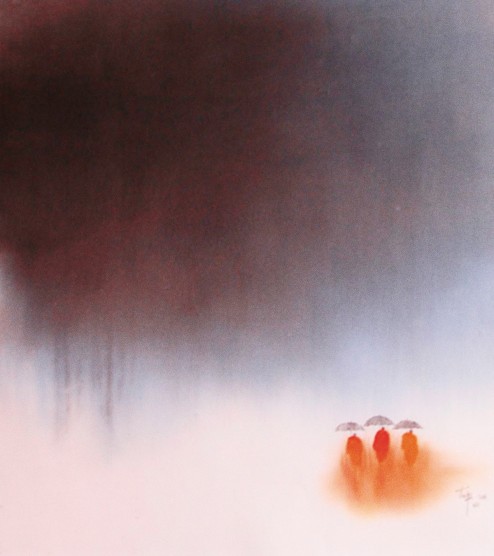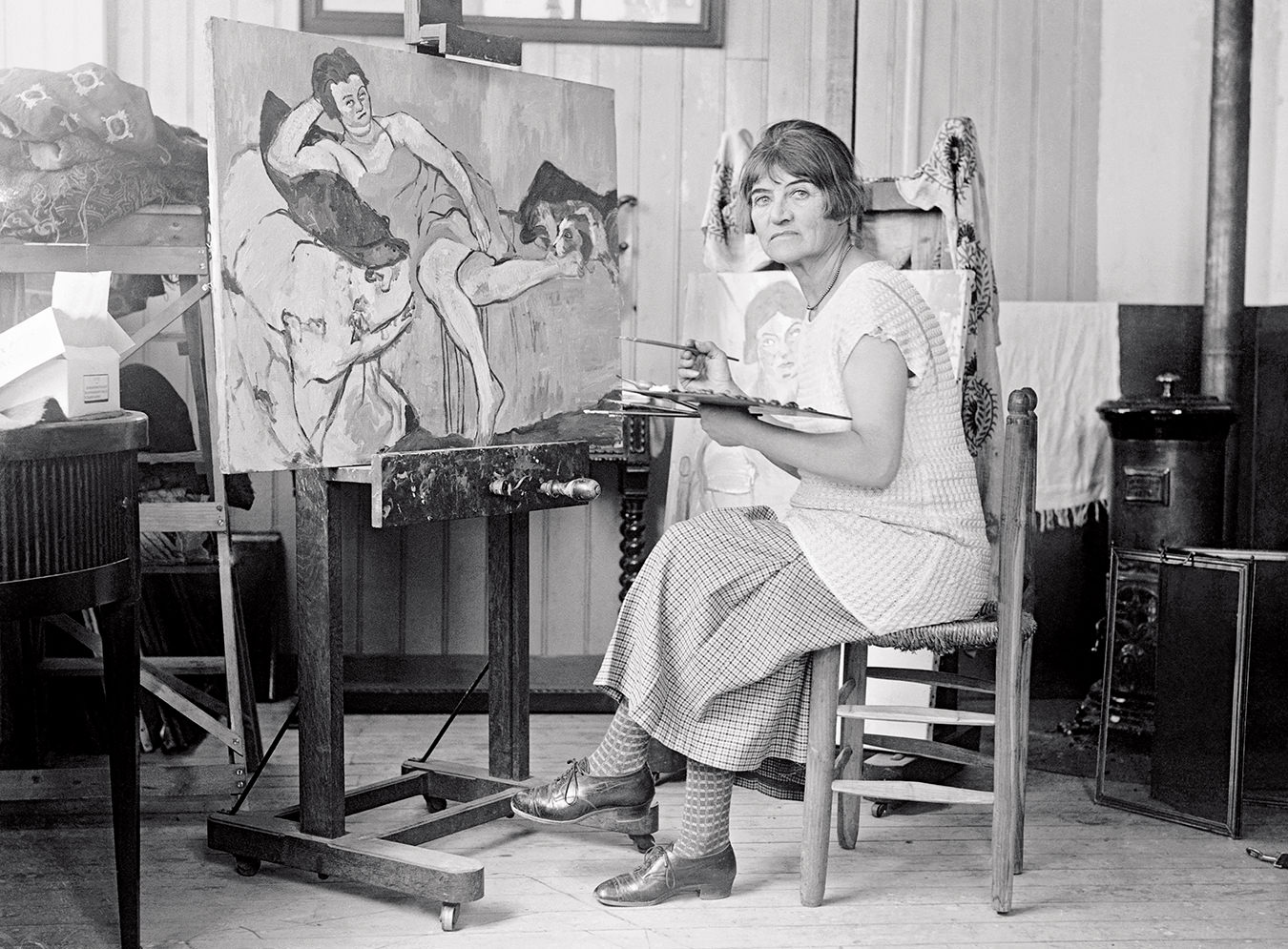Artist Thép Thavonsouk
Through the haze.

Dawn in Luang Prabang. Materializing through the morning haze, a Buddhist monk in saffron robes appears, and then another. Soon a long file is moving quickly along the street, accepting alms of sticky rice from the devout who kneel at the sidewalk’s edge. Flickering flames in a monochromatic landscape, the monks have become an iconic image of this northern Laos town. Emerging from Thép Thavonsouk’s brush, they are tiny, stylized figures, miniature orange exclamation points dwarfed by clouds, veiled by mist, just a quiet allusion dissolving into the landscape.
Laotian-born Thavonsouk lives and paints in a two-storey “semi-colonial” building on what he calls a ruelle—a little street—an appropriate word in this French-inflected town whose classic colonial architecture and abundance of temples have earned it the designation of a UNESCO World Heritage Site. From across the brick-paved laneway comes the sound of a three-string violin, a xylophone, drums, and the typically Laotian khong vong gong instrument. Visible at one end of the street is the emerald hump of Phou Vao mountain; at the other, the golden façade of a temple. The setting could not be more different from what Thavonsouk considers his real home, where he spends half the year. “I love Canada,” says the Calgarian. “I’m very, very grateful for my Canadian identity.”
The eldest of eight, he grew up in Laos with a mother who dyed and wove her own silk and a father in the Ministry of Education. From childhood, Thavonsouk drew and painted still lifes and landscapes—“especially boats and life on the Mekong River.” In 1967, a Fulbright scholarship took him to New York to study diplomacy. Five years later, he immigrated to Canada to teach languages. (“A Canadian by choice—I didn’t leave Laos as a refugee,” he says.) He interpreted the local scenery in gouache, oils, and watercolour—but “I let that go once I got into my silent revolution,” he says, referring to an incident that occurred around 2003, when a visitor to an exhibition in Bangkok was moved to tears by a painting from his June Rain series, in which the scenery is diffused almost, but not quite, to abstraction, a style that now informs his work.
“The inspiration from the Mekong, the mist, and the hundreds of monks in saffron robes at 6 a.m. is such that I have no difficulty incorporating them in my works,” he says. He talks also of the Festival of Light, held in October, when bamboo boats, flowers, candles, and incense are floated on the Mekong River and hundreds of lanterns are released into the night sky, images that will appear in the Nocturne series that he is currently working on. In oils, watercolour, and pastel, on canvas, linen, and rice paper, he distills his culture into haunting images.

June Rain I.
He had been returning to Laos since 1989, and in 2005 he replanted his roots. “It’s a home first, gallery second,” he says of the former motorcycle repair shop he bought and transformed into a serene, modern space. Its name, Saaifone, both honours his mother and describes “a ‘thread’ of rain, as in silk.” The airy, white-painted space speaks the traditional Laotian language of teak, rosewood, and rattan, except in its sanded and polished concrete floor. “It took 35 years to have this patina,” says Thavonsouk.
His ethereal art quietly displays his passion for nature and the seasons, his luminous atmospheres evoking 19th-century artists Turner and Whistler. These are just two masters Thavonsouk researches when he travels, along with others including “Rothko, Constable, and Titian. Veronese, Caravaggio especially. I look at their work and learn,” he says, diffusing their influence through his own lens in the same way that the local mists cast a theatrical scrim over the river. “There will always be elements of rain, cloud, mist, and fog in my works,” he says. “As well, there will be spaces for light, for shadows and negative spaces depicting the universe, the silence, the stillness in the atmosphere.”
From the scented pale stars of frangipani to the stellar profusion seen in skies unpolluted by city lights, it’s not just a 14-hour time difference that distinguishes Luang Prabang from Calgary. When in Laos, Thavonsouk misses playing tennis indoors (his condo is two blocks from a tennis club). In Canada, he says, “I miss the soft breeze, the gentle way of life, the butterflies, and the many colours of bougainvillea.” A Buddhist monk, he still takes cooked food from restaurants to nearby temples every day.
Like his paintings, the painter has a contagious serenity. “It’s my upbringing,” says Thavonsouk, “I carry that with me. It is important for an artist to be a human being first, meaning to me that your heart and your head should be well filled. The painting techniques, styles, talent—these come second. To be a full-fledged artist, I have to be a well-accomplished human being.”
Photos of paintings by Owen Malenka.




